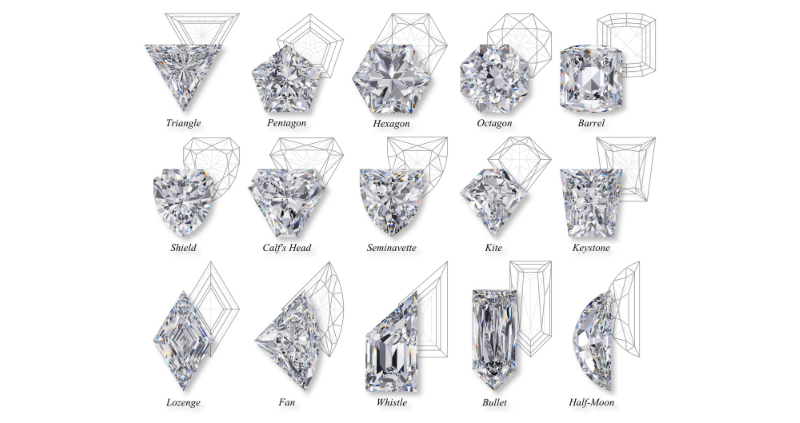Evaluating Fancy-Shaped Diamonds: What to Look for Beyond the Cut
When shopping for diamonds, most people focus on the popular round brilliant cut. However, fancy-shaped diamonds, which include shapes like princess, cushion, oval, and pear, offer a unique appeal and stand out with their distinct characteristics.

When shopping for diamonds, most people focus on the popular round brilliant cut. However, fancy-shaped diamonds, which include shapes like princess, cushion, oval, and pear, offer a unique appeal and stand out with their distinct characteristics. Evaluating fancy-shaped diamonds requires a bit more attention, as the traditional cut grade used for round diamonds doesn't always apply. Here’s what to look for when evaluating fancy-shaped diamonds and how to go beyond just the cut.
What is the Cut Grade for Fancy Diamonds?
Unlike round brilliant diamonds, fancy-shaped diamonds do not have a universally accepted cut grading system. The cut of a fancy diamond refers to how well the diamond's proportions, symmetry, and polish reflect light. However, these diamonds are not assigned specific cut grades (like Excellent, Very Good, etc.) by major certification bodies like the GIA. Instead, each fancy shape is evaluated individually, considering how well it maintains symmetry, facet alignment, and proportion to maximise brilliance.
What is Considered a Fancy Cut Diamond?
Fancy cut diamonds refer to any diamond shape that is not round. These shapes include:
- Princess: Known as the square has sharp corners, this cut offers excellent brilliance due to its multiple facets.
- Cushion: Often referred to as a "pillow-cut" diamond, the cushion shape combines a square cut with rounded corners, offering vintage appeal.
- Oval: Oval-shaped diamonds provide an elongated shape that enhances finger length and often maximises carat weight.
- Emerald: This rectangular cut with step facets and large, open table emphasises clarity over sparkle, making it perfect for diamonds with fewer inclusions.
- Pear: With its distinctive teardrop shape, pear diamonds offer both elegance and uniqueness.
Other fancy shapes include radiant, marquise, and heart-shaped diamonds. These shapes add personality to the diamond and appeal to those looking for something beyond the classic round.
How Can You Tell if a Diamond is a Good Cut?
For fancy-shaped diamonds, assessing the quality of the cut goes beyond the grade. Key factors to consider are:
- Proportions: The diamond’s length-to-width ratio greatly affects its appearance. For example, an ideal oval or pear-shaped diamond has a balanced length-to-width ratio that neither looks too elongated nor too short.
- Symmetry: Symmetry plays a critical role in how light passes through the diamond. Uneven facets can distort the way light reflects, affecting the brilliance. Well-cut fancy shapes will have symmetrical sides, with facets perfectly aligned.
- Polish: A diamond with a high polish reflects more light and adds to the overall sparkle. Check the polish grade to ensure it’s at least "Good" or higher.
- Light Performance: Check how light interacts with the diamond. Does it have a pleasing sparkle? Are there areas that appear dark or dull, also known as "bow-tie" effects? This can be a sign that the diamond is not optimally cut.
What Are the Distinguishing Characteristics of an Ideal Cut Diamond?
For round diamonds, an “ideal cut” maximises brilliance, fire, and scintillation. However, for fancy-shaped diamonds, the concept of "ideal" can be more subjective. Here are key characteristics that define an excellent fancy-shaped diamond cut:
- Balance and Symmetry: The sides should be well-balanced, and the facets should be aligned evenly. For example, an ideal pear-shaped diamond will have a perfectly centred point, with both sides identical in length and curvature.
- Minimised Bow-Tie Effect: In some fancy shapes like oval, marquise, or pear, a bow-tie effect is common. This dark area across the centre of the diamond results from poor light reflection due to improper cutting. While some bow-tie is expected, an ideal cut minimises it to ensure maximum light dispersion.
- Perfect Proportions: The overall dimensions of the diamond—depth, table, and crown height—should be balanced to allow for optimal light return. In many fancy cuts, a deeper depth or a larger table can compromise the diamond’s sparkle. A well-cut diamond should avoid being too deep or too shallow.
- Polish and Clarity: Ideal fancy-shaped diamonds should have a high polish grade, and clarity should be carefully evaluated. Unlike round diamonds, where inclusions can be masked by brilliance, fancy-shaped diamonds often show inclusions more easily, particularly in step-cut shapes like emerald.
Beyond the Cut: Additional Considerations
While the cut is a significant factor, there are other important aspects to evaluate when choosing a fancy-shaped diamond.
- Carat Weight: Fancy-shaped diamonds often appear larger than round diamonds of the same carat weight due to their elongated or unconventional shapes. For example, an oval or marquise can provide more finger coverage, offering a larger appearance for less weight.
- Colour: Colour is more noticeable in fancy-shaped diamonds, especially in cuts with larger tables (e.g., emerald, cushion). It’s essential to choose a higher colour grade if you want the diamond to appear more colourless, particularly if it will be set in a white metal like platinum or white gold.
- Setting: The choice of setting can also influence how the fancy diamond looks. Some settings accentuate the shape, such as a halo for pear or oval shapes, while others emphasise its brilliance. It’s important to select a setting that complements the diamond shape and maximises its visual impact.
Conclusion
Evaluating fancy-shaped diamonds involves looking at more than just the cut. Each shape brings unique characteristics, and understanding what makes a diamond’s cut exceptional can help you find the perfect one. Focus on proportions, symmetry, polish, and light performance to determine the quality of a fancy-shaped diamond. Remember, the shape you choose can dramatically affect the appearance, brilliance, and overall aesthetic of your diamond jewellery.
By considering these factors, you can confidently select a fancy-shaped diamond that suits your style and preferences, ensuring you get the best value for your investment.
If you're in the diamond industry, GA Demands offers a seamless B2B platform where buyers and sellers can connect directly, without middlemen. Download the app today to boost your diamond buying and selling experience with ease and efficiency.

